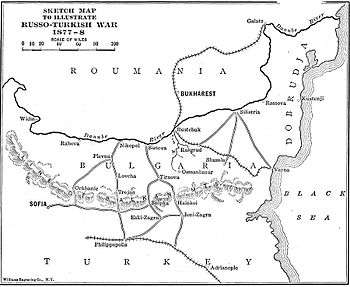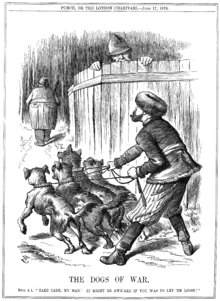Russo-Turkish War (1877–1878)
Russian-Ottoman War (1877-1878)
Part of: Russian-Turkish Wars
Russian-Ottoman War (1877-1878)
Zimnicea - Nikopol - 1st Shipka Pass - Elena - 2nd Shipka Pass - Pleven - Lovech - 3rd Shipka Pass - Kızıl Tepe - Alajah - Gorni-Dubnik - Kars - Tashkesen - 4th Shipka Pass - Plovdiv
The Russo-Ottoman War of 1877-1878, also called the Russo-Turkish War of 1877-1878 (Turkish 93 Harbi because of the Rumi calendar), was a military conflict between the Russian Empire and the Ottoman Empire. The war took place mostly on the territory of Bulgaria and ended with a victory for Russia, whose troops were about 20 km from Istanbul at the end of the fighting. However, as the other European powers saw the balance in Europe endangered by a disproportionate increase in Russia's power, the results of the Russo-Turkish peace of San Stefano were restricted to a considerable extent at the Congress of Berlin.
The immediate triggers of the war were the Ottoman repressions against the Serbs and the Bulgarians after the Serbian-Ottoman War and the Bulgarian April Uprising. In the context of pan-Slavism, Russia perceived itself as the protective power of these peoples, and the social mood in the country demanded intervention. Russia's strategic goals also included access to the Mediterranean free from its geopolitical rival. The Serbs and the Bulgarians, who regained their independence in the course of the war for the first time in centuries, now regard this event as the second birth of their national history. Bulgarian historiography officially refers to the Russo-Turkish War of Liberation and the victory over the Turks as the Bulgarian Revival. The war also provided Romania with the opportunity to declare full independence. Although it was never directly part of the Ottoman Empire, unlike other areas of the Balkans, it was officially under its suzerainty. In Romanian history, the war is therefore referred to as the Romanian War of Independence.

The places, roads and passes of the war zone
Previous story
→ Main article: Conference of Constantinople
In Bosnia-Herzegovina, an uprising against the Ottomans occurred in the summer of 1875. The main reason for this revolt was the heavy tax burden imposed on the population by the Ottoman administration, which was financially on the verge of bankruptcy. Despite the relaxation of taxes, the revolt continued into 1876 and in turn triggered the Bulgarian April Uprising of 1876. Tensions in Bosnia and Russian support encouraged the principalities of Serbia and Montenegro to declare war against their nominal Ottoman rulers.
The Serbian-Turkish War strengthened the imperial ambitions of the great powers Russia and Austria-Hungary, so that on 8 July 1876 Alexander Mikhailovich Gorchakov and Gyula Andrássy reached the Reichstadt Agreement, by which they divided the Balkans into their two spheres of influence. In August 1876, the Serbian army, in which many Russian and Bulgarian volunteers also served, was defeated by the Ottoman army. This was the most unfortunate scenario for Russia and Austria-Hungary, as they now had no good prospects for territorial claims against the Ottoman Empire.
During the Bulgarian April Uprising of 1876, the Batak massacre occurred, which became a symbol of the atrocities committed against the Slav civilian population by the Ottoman army in both Bulgaria and Serbia and startled Western public opinion. Victor Hugo, Dostoevsky, Aksakov, Garibaldi and other notable figures protested.
In December 1876, the ConstantinopleConference was held to discuss autonomy and the boundaries of one or more future autonomous Bulgarian provinces within the Ottoman Empire. However, the Ottomans boycotted the event and eventually dissolved it. The conference was interrupted by the Turkish Foreign Minister, who informed the delegates that the Ottoman Empire had adopted a new constitution. This guaranteed the rights and freedoms of all ethnic minorities in the Ottoman Empire, and Bulgarians would have the same rights as all Ottoman citizens.
Russia's attitude towards the Ottoman Empire remained hostile, however, as the Ottoman constitution was seen only as a pretextual sham. Through diplomatic negotiations in January 1877, the Russians secured Austria-Hungary's neutrality in the event of future military conflict. In return, Austria-Hungary was to be allowed to occupy Bosnia and Herzegovina after this war.
In Britain, public opinion was mixed regarding the Balkans. Despite widespread sympathy for the Bulgarian struggle for freedom, Benjamin Disraeli was a fierce opponent of a Russian rise to power. He positioned Britain as the protector of the Ottoman Empire, as had been the case in the Crimean War. However, the British diplomat Lord Salisbury negotiated a compromise agreement with the Russian envoy Count Nikolai Ignatiev. Bulgaria was to be transformed into an eastern and a western province, Bosnia-Herzegovina into a unitary province, and given a high degree of autonomy, including its own parliament and police force. Serbia was guaranteed territorial integrity and Montenegro was to be allowed to retain territories in northern Albania and Bosnia that it had conquered earlier in the war.
The other powers were blocked in their freedom of action because there was broad support in Europe for an independent Bulgaria, or because they were preoccupied with their internal problems. There were general doubts about Russia's military capabilities. In April Russia concluded an agreement with Romania under which it was allowed to march its troops through the country. The same agreement assured Russia the annexation of southern Bessarabia (the area had already been under Russian control from 1812-1856), while Romania was promised northern Dobruja.

British propaganda: Russia is ready to unleash its dogs of war on the Ottoman Empire. England stands behind the fence.
Initial situation
Russia declared war on the Ottoman Empire on April 24, 1877. The Russians initially marched on Bessarabia with an army of about 180,000 men (VIII, IX, XI and XII Army Corps), joined by the VII and X Army Corps intended for securing the Black Sea coast. Army Corps, which was intended for securing the coast of the Black Sea. Still on the evening of April 24, four columns of the Russians managed to cross the Prut River almost undisturbed. At the same time, Major General Skobelev managed to capture a bridge over the Sereth near Barboschi, which secured the railway line to Bucharest.
The Peace of Paris in 1856 created an artificial line in Bessarabia, which was drawn on the border between Russia and Turkey through the territory of the Danubian Principalities. During the following war, the Russians built a new railway line directly from Bender to the Dniester to Galatz, and the Romanian railway line from Giurgevo to the bridge at Zimnicea-Sistova was also laid out for future operations against Turkey.
The Ottomans under Abdülkerim Nadir Pasha had assembled some 160,000 men to protect the 825-kilometre-long Danube line, and they also had control (awarded after the Crimean War) of the Black Sea. Turkish gunboats also patrolled the Danube. However, the Danube squadron soon lost the ironclad Lüfti-Dschelil off Brăila and, on 25 May, the monitor Hefzi-Rahman at Matshin to Russian shells and torpedo boats. However, due to a lack of combat readiness, the Ottomans were able to command only 25% of their military resources most of the time. In addition, Ottoman reconnaissance could not get any information about Russian plans, so the Ottoman leadership was in complete ignorance about them. Therefore, the Ottomans preferred to stay close to their fortifications and wait for the enemy.
In the guesswork over Russian plans, the Ottoman command in Istanbul made a strategic mistake: Assuming that the Russians would be too "lazy" to cross the Danube far from the delta and would instead take the shortest route across the Danube delta, even though it was heavily fortified, they stationed most of their garrisons in that area. Inland on the Danube they had only one well-manned fortress at Widin, whose occupation by Osman Pasha's troops was due only to the fact that these troops had only recently been involved in the war against Serbia.

Nikolai Dmitriyev-Orenburgski: Russian Crossing of the Danube, 1883
Search within the encyclopedia